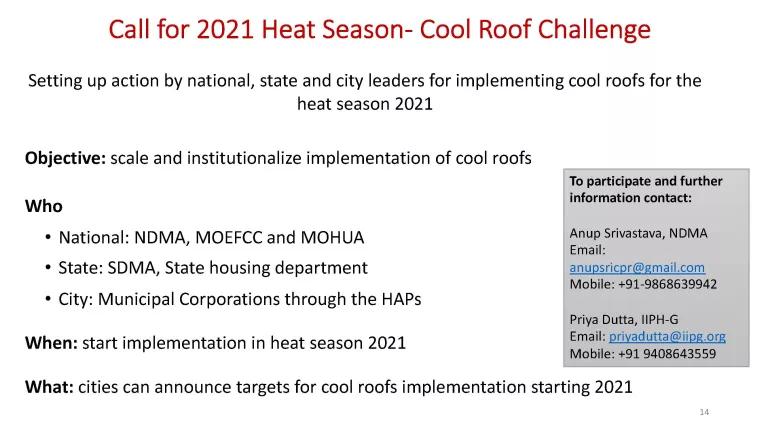Heat Action Plans 2021: Cool Roofs Challenge

Co-authored with Polash Mukerjee and Jessica Korsh
Last year, 2020 is essentially tied with 2016 as the hottest year on record, according to NASA. The world’s seven-warmest years have all occurred since 2014, and in 2020 the Northern Hemisphere saw its hottest year on record. Extreme heat is not merely an inconvenience; it is a major global health threat and can be deadly. Exacerbated by climate change, many Indian states experienced dangerous heatwaves last year. Ahead of the upcoming heat season, the National Disaster Management Authority (NDMA) will lead states to ramp up Heat Action Plans—with a new initiative this year “Heat Action Plans 2021: Cool Roofs Challenge.
Prime Minister Modi, recognizing the country’s vulnerability to climate change, announced that India will exceed its Paris Agreement targets. Speaking at the virtual Climate Adaption Summit 2021, PM Modi expressed "our actions show our commitment," and announced plans to restore 26 million hectares of degraded land and target 450 gigawatts of renewable energy capacity by 2030. Additionally, the country will promote LED lights to save 38 million tons of carbon dioxide emissions annually.
Heat Action Plans and community outreach have proven to be effective in reducing mortality on hot days enhancing community resilience to extreme heat episodes. India’s first Heat Action Plan developed by NRDC, Indian Institute of Public Health, Gandhinagar (IIPH-G) and partners, the Ahmedabad Heat Action Plan, was originally released in 2013 and has since expanded to over 23 states and over 100 cities and districts through the leadership of NDMA.
Low-cost heat response strategies such as cool roofs, which reduce indoor temperatures, bring down the dependence on air conditioners, and address the urban heat island challenge, are required. Cool roofs reflect sunlight and absorb less heat. Depending on the setting, they can help lower indoor temperatures by 2 to 5°C (3.6 - 9°F) as compared to traditional roofs. These roofs also potentially lead to less air pollution since they save energy, especially on cooling appliances, such as fans and air conditioners.
Cool Roofs Programs are a target-based programs that aim to expand the installation of cool roofs in the city or the state. The Cool Roofs Program focus on yearly targets and implementation plans to increase installation of cool roofs within cities and across the state.
Cities can lead the way in cool roof implementation. Ahmedabad in Gujarat and Hyderabad in Telangana initiated pilot cool roof programs in 2017 and 2018 respectively. In 2020, NRDC, IIPH-G in partnership with Mahila Housing Trust (MHT) painted roofs of selected slum households with solar reflective paint, as demonstration projects, in four cities—Jodhpur, Surat, Bhopal, and Ahmedabad. The demonstrations covered 426 households and 140,385 square feet of roof across the four cities.
With the ongoing COVID-19 pandemic, planning ahead and preparing for extreme weather continues to be more important than ever. People living in slums and low-income communities are particularly vulnerable—a large percentage of their homes are far from optimal, with few options for cooling and highly compromised living conditions. And for such households social distancing is also virtually impossible.
“Climate adaptation is more significant today than ever before and that it is a key element of India's developmental efforts,” said PM Modi at the Climate Adaptation Summit 2021. Ahead of the 2021 heat season, cities, states and the national government are taking steps to protect communities and save energy costs, through cool roof programs.
Polash Mukerjee is a climate health and air pollution expert working with NRDC as a consultant based in New Delhi. Jessica Korsh is a former NRDC Duke Stanback Fellow.
